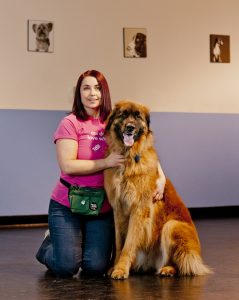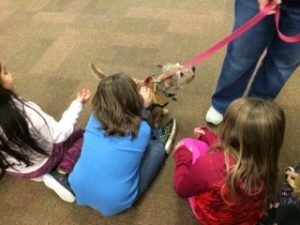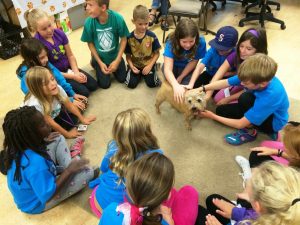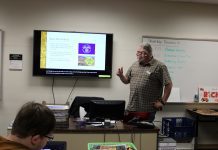To say Whatcom County is a dog-friendly area may be a bit of an understatement. One would be hard-pressed to spend a day—or even an hour—within its boundaries without spotting a number of furry friends walking down sidewalks, riding in cars, jogging on trails and peeking out of grocery carts. Wherever the people go, their canine companions are usually trotting along right beside them.

And when there are so many adorable pets out in public, it’s only natural for many people to want to say hello. But dogs are still animals and there’s the matter of safety to be considered, especially when children are the ones introducing themselves.
So, what’s the best way to greet a dog? Angela Lenz, owner and lead trainer at Tails-A-Wagging, has been volunteering her dog safety expertise in the school system for more than 20 years. She is working hard to educate the community on a method she incorporated into her outreach programs about three years ago, Pat-Pet-Pause, which aims to change how we approach dogs on every level.
“The old way to approach a new dog–stick your hand out and let the dog sniff it—was really troublesome, as kids were getting bit on their hand and there is the issue of consent,” says Lenz. “Just like kids, dogs have the right to say no. They should not be forced to be touched if they don’t want to be.”

Lenz explains that seventy-seven percent of all dog bites happen by a family pet, when an adult is less than 12 inches away. She believes this means that people are staying close by and paying attention but they don’t always recognize the warning signs.
“Until we teach parents and kids about how to respect dogs by understanding body language, we won’t stop dog bites,” says Lenz. “Dogs are the only animal on the planet that we have such high expectations of. They are expected to never be afraid, never be upset, never tell someone how they feel and be happy all the time. Dog bites do not happen at random or come from nowhere. We can always see them coming—you just need to know what to look for.”
Lenz is taking her Pat-Pet-Pause movement straight to the schools, educating kids as young as preschool age how to respectfully introduce themselves to a new dog. She sits right down on the floor with the students and teaches them about canine body language in a variety engaging ways, even if it means crawling on the floor like a puppy to demonstrate a behavior.

“I also show them photos about what dogs look like when they are happy, when they are sad, when they are mad and when they are afraid,” Lenz says.
She then explains the Pat-Pet-Pause method and they all practice how it’s done. Next comes the fun part: Lenz brings in Bubba, her helper dog for the past 15 years, who’s more than happy to provide the students with some hands-on meet-and-greet experience while the kids get quizzed about his body language and movements.
“Stop and look first,” Lenz says. “Happy dogs are relaxed, with open mouths and exposed tongues, ears are relaxed and weight is evenly distributed.”

The informative program is 100% volunteer and facilitated through the Whatcom Humane Society’s education department, with which Lenz has been volunteering since 1998. She works closely with WHS in many ways including presenting free monthly workshops, allowing shelter dogs into Tails-A-Wagging daycare for socialization, and helping staff and volunteers with training, evaluations and adoption counsel whenever needed.
“The program at the elementary schools is just one more way she is helping us teach kids—and adults—about canine body language and safety,” says Carly Brewer, WHS Volunteer & Outreach Services Manager. “She is amazing!”
Zakia Kaminski, who works closely with Lenz through WHS Outreach and Humane Education, has already witnessed a positive response from the children and—even more rewarding—a thoughtful shift in behavior. When returning to Alderwood Elementary for a second presentation, she witnessed students in the hall using the skills they learned from the Pat-Pet-Pause program just days earlier.

“It was very impressive to see and definitely made me feel as though the presentation made a difference,” says Kaminski. “Humane education is such an important thing for the community and the younger a child is taught something such as dog safety or dog body language, the more likely they are to carry that idea through to adulthood.”
Lenz has been working as a dog trainer since 1989 and opened Tails-A-Wagging in 1997. To learn more about arranging a Pat-Pet-Pause presentation at a school or organization, contact WHS at 360-733-2080 or outreach@whatcomhumane.org.










































